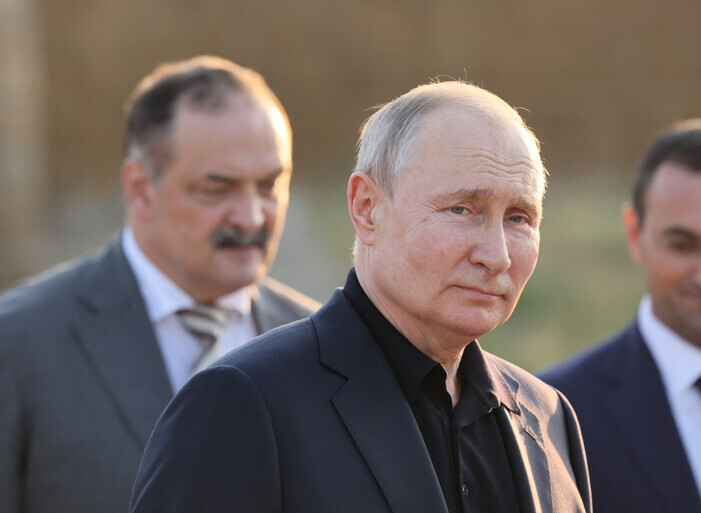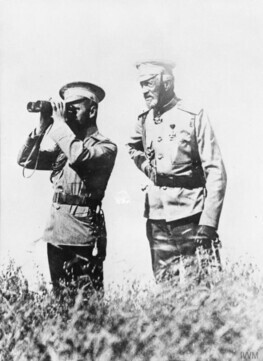hankyoreh
Links to other country sites 다른 나라 사이트 링크
Why Putin is evoking the chaos of 1917 in the face of the Wagner mutiny

“Putin reads all the time, mostly about the history of Russia. He reads memoirs, the memoirs of Russian historical state figures.”
This remark was shared with the news agency Reuters in 2011 by Kremlin press secretary Dmitry Peskov.
Indeed, President Vladimir Putin of Russia has tended to thumb back through his country’s history when confronting major events and decisive moments. It offers insights as to what was done wrong in response to such situations in the past, and what needs to be done to rectify problems and restore former glories.
In launching an invasion of Ukraine in February 2022, Putin justified the war with a speech insisting that the country was historically part of Russia. His emphasis on a “historical mission” shares similarities with the rhetoric of Chinese President Xi Jinping, who speaks of a “Chinese Dream” that signifies a great revival of the Chinese people.
When confronted with a rebellion by the Wagner Group on June 24, Putin recalled the history from a century earlier as he stressed the need to avoid a repeat of 1917. What were his reasons for bringing up that particular year?
Putin reliving the nightmare of 100 years ago?In a televised speech, Putin said the chaos that occurred at the time came about because a blow like this was dealt to Russia in 1917, when the country was fighting in World War I,” which led to victory being “stolen.”
“Intrigues, squabbles and politicking behind the backs of the army and the nation turned into the greatest turmoil, the destruction of the army and the collapse of the state, and the loss of vast territories, ultimately leading to the tragedy of the civil war,” he continued.
The year 1917 was marked by extremely dramatic events even by the standards of the upheavals suffered by Russia during the 20th century.
Czar Nicholas II, who had led Russia during WWII, was forced out in the February Revolution, which erupted due to the massive loss of life and economic collapse. This brought an end to the Romanov dynasty.
In August 1917, the Russian Army’s Commander-in-Chief Lavr Kornilov launched a rebellion under the provisional government of Aleksander Kerensky. This was followed by the October Revolution, where power was assumed by the Bolsheviks, led by Vladimir Lenin.
In May 1918, the Bolshevik government broke away from the Allied powers (which included Great Britain, France and the US) to sign an independent peace treaty with Germany and the Austro-Hungarian Empire. The Bolshevik Revolution ignited a civil war that would last until 1923.
These were the events summed up by Putin. In his view, Russia had been weakened by divisions in its ranks brought about by the revolution and civil war, which led in turn to the humiliating concessions of the Treaty of Brest-Litovsk.
Drawing an analogy between that situation and Russia’s current all-out commitment to the war in Ukraine, he explained that the eruption of rebellion signified a major crisis.
“This battle, when the fate of our nation is being decided, requires consolidation of all forces. It requires unity, consolidation and a sense of responsibility, and everything that weakens us, any strife that our external enemies can use and do so to subvert us from within, must be discarded,” he stressed, denouncing the Wagner Group rebellion as an of sticking “knife in the back of our country and our people.”
While Putin’s speech seemed to cover the entirety of the events in 1917, the fact that it was delivered in response to the Wagner Group rebellion suggests that the main focus may have been on the Kornilov putsch.
Lavr Kornilov, judging that victory in the war required domestic stability and the elimination of subversive elements, marched his troops toward the Russian capital of Petrograd (today known as Saint Petersburg), which was under the control of socialists. Kornilov described this as being done on behalf of Kerensky’s provisional government, but Kerensky relieved Kornilov of command for what he regarded as a coup attempt. The rebellion ended in failure as troops deserted and the Russian people, already exhausted from the war, turned their backs on Kornilov.
The Kornilov putsch bears similarities with the actions by Yevgeny Prigozhin, head of the Wagner Group, who was marching on Moscow with the stated goal of eliminating the Russian army leadership. Prigozhin too claimed that he wasn’t challenging Putin’s authority, but he was ultimately branded a traitor, leading to the collapse of his rebellion.
The first step in Prigozhin’s announced advance on Moscow was seizing the city of Rostov-on-Don, which is near Ukraine. Coincidentally, that’s the same area where Kornilov raised an army after escaping from jail, where he’d landed after his failed putsch.
Putin has brought up the year 1917 while emphasizing that his invasion of Ukraine was aimed at setting right Lenin’s mistake. Putin believes that Lenin’s decision to set up the Soviet Union as a multinational state sowed the seeds of division and represented a ticking time bomb.
In a speech in 2016, Putin criticized Lenin for incorporating the Donbas region into the Ukrainian People’s Republic, then part of the Soviet Union, for political expediency. Donbas is the site of the fiercest fighting between Russia and Ukraine.

While the historical incidents evoked by Putin are more than a century old, Russia’s invasion of Ukraine has been compared since the beginning of hostilities to the Soviets’ armed conflict in Afghanistan in the 1980s. First, Russia’s objectives are the same in both cases: installing a reliably loyal government and setting up a definite buffer state.
The Soviet leadership at the time was concerned that an Islamist regime might take over Afghanistan or that the US might establish military bases there. Similarly, Russia’s decision to invade Ukraine was partly aimed at preventing Ukraine from joining NATO.
Another similarity is that the Russians’ adversaries have proved much tougher than expected.
When the Soviets invaded Afghanistan in December 1979, they expected that the war would last six months, or a year at the longest. Sure enough, the capital of Kabul and other urban areas easily fell to the Soviet forces. But the Soviets were soon entangled in guerilla warfare with the mujahideen, and the war dragged on for ten years.
At the beginning of hostilities in Ukraine, Putin described his invasion as a “special military operation” and seemed to regard it as being less than an all-out war. But Russian troops were halted on the way to the Ukrainian capital of Kyiv, and the fighting has settled into a protracted war, so far lasting one year and five months. Russia’s casualties are already several times what the Soviets suffered in the war in Afghanistan.
In both Afghanistan and Ukraine, Western countries including the US and the UK provided weapons to the local resistance without putting boots on the ground. And in the Soviet-Afghan War, just as today, Western countries criticized the Soviet Union and imposed sanctions on it.
This war in Afghanistan is considered one of the principal causes of the collapse of the Soviet Union, which Putin considers “the greatest geopolitical catastrophe of the 20th century.” While the human cost and economic losses were considerable, some stress that the war shattered the Red Army’s “myth of invincibility.” With the Soviet Union seemingly incapable of exercising force as it had in Hungary and Czechoslovakia in the 1950s and 1960s, the countries of Eastern Europe defected from the Soviet Union, and independence movements flared up in Soviet republics populated by non-Russian ethnic groups.
If the prolongation of the war in Ukraine inflicts more damage on Russia and arouses resentment in the public, Putin’s invasion is likely to draw many comparisons to the Soviet-Afghan War. Michael McFaul, former US ambassador to Russia, even remarked that “Ukraine is Putin’s Afghanistan.”

In the end, Putin’s mention of the year 1917 voices a fair amount of panic. The rebellion itself was bad enough, but Prigozhin’s outright denial of the legitimacy of the war has made things even worse.
In a video posted to Telegram, the warlord said that the Russian Ministry of Defense had “tried to deceive the public and the president with lies about Ukraine planning to attack Russia along with NATO.” He also said that Russian soldiers had been treated like cannon fodder because of bungled operations and poor preparations for the war.
In short, the man who led the mercenary group funded by Putin publicly declared that the justification given for Putin’s war had been fabricated.
Putin’s historical analogy is not without its merits, but it’s logically flawed. He argues that Russia was robbed of victory in World War I because of internal divisions. But those divisions were fueled by Russians’ frustration about the lack of any signs that the war would end despite the awful human toll and economic privation. In short, internal division was not the cause of defeat, but the result of defeat.
Once again, a rebellion has arisen while a war that everyone assumed would be over soon has instead become protracted. One could even say that Putin, in his analogy, has mixed up cause and effect.
One thing that Putin hasn’t said is that there’s a historical pattern in Russia — which has seen more revolutions than other major powers — in which governments collapse when they fail to extricate themselves from unwinnable wars.
“As Kerensky found in 1917, the Russian public is likely to withdraw its support from Putin when wars go badly,” observed Robert Service, professor emeritus at Oxford University, in a piece published by Foreign Policy.
By Lee Bon-young, Washington correspondent
Please direct questions or comments to [english@hani.co.kr]

Editorial・opinion
![[Column] Is Korean democracy really regressing? [Column] Is Korean democracy really regressing?](https://flexible.img.hani.co.kr/flexible/normal/500/300/imgdb/original/2024/0705/2917201664129137.jpg) [Column] Is Korean democracy really regressing?
[Column] Is Korean democracy really regressing?![[Column] How tragedy pervades weak links in Korean labor [Column] How tragedy pervades weak links in Korean labor](https://flexible.img.hani.co.kr/flexible/normal/500/300/imgdb/original/2024/0703/8717199957128458.jpg) [Column] How tragedy pervades weak links in Korean labor
[Column] How tragedy pervades weak links in Korean labor- [Column] How opposing war became a far-right policy
- [Editorial] Korea needs to adjust diplomatic course in preparation for a Trump comeback
- [Editorial] Silence won’t save Yoon
- [Column] The miscalculations that started the Korean War mustn’t be repeated
- [Correspondent’s column] China-Europe relations tested once more by EV war
- [Correspondent’s column] Who really created the new ‘axis of evil’?
- [Editorial] Exploiting foreign domestic workers won’t solve Korea’s birth rate problem
- [Column] Kim and Putin’s new world order
Most viewed articles
- 1[Column] Is Korean democracy really regressing?
- 2Real-life heroes of “A Taxi Driver” pass away without having reunited
- 3Beleaguered economy could stymie Japan’s efforts to buoy the yen
- 4What will a super-weak yen mean for the Korean economy?
- 5Car behind deadly crash began rapid acceleration after exiting underground garage
- 6‘No specific purpose’: Experts on how Big Tech attempts to create demand for AI
- 7[Editorial] Chun Doo-hwan: Gone but never to be forgiven
- 8Experts cast doubt on driver’s claim that sudden unintended acceleration caused deadly crash
- 9South Koreans living near border with North unnerved by return of artillery thunder
- 10Shoddy records help Korean hospitals conceal abuse of mentally ill